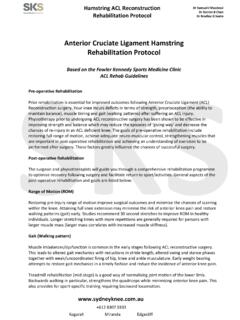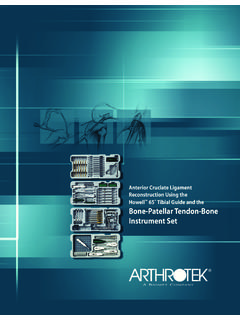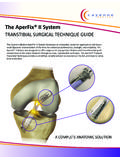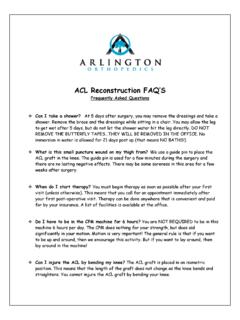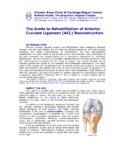Transcription of Anterior Cruciate Ligament Hamstring …
1 +612 8307 0333 Kogarah Miranda Edgecliff Dr Samuel J Macdessi Dr Darren B Chen Dr Bradley G Seeto Hamstring ACL Reconstruction Rehabilitation Protocol Anterior Cruciate Ligament Hamstring Rehabilitation Protocol Based on the Fowler Kennedy Sports Medicine Clinic ACL Rehab Guidelines Pre-operative Rehabilitation Prior rehabilitation is essential for improved outcomes following Anterior Cruciate Ligament (ACL) Reconstruction surgery. Your knee incurs deficits in terms of strength, proprioception (the ability to maintain balance), muscle timing and gait (walking patterns) after suffering an ACL injury. Physiotherapy prior to undergoing ACL reconstructive surgery has been shown to be effective in improving strength and balance which may reduce the episodes of giving way and decrease the chances of re-injury in an ACL deficient knee.
2 The goals of pre-operative rehabilitation include restoring full range of motion, achieve adequate neuro-muscular control, strengthening muscles that are important in post-operative rehabilitation and achieving an understanding of exercises to be performed after surgery. These factors greatly influence the chances of successful surgery. Post-operative Rehabilitation The surgeon and physiotherapists will guide you through a comprehensive rehabilitation programme to optimize recovery following surgery and facilitate return to sport/activities. General aspects of the post-operative rehabilitation and goals are listed below: Range of Motion (ROM) Restoring pre-injury range of motion improve surgical outcomes and minimise the chances of scarring within the knee. Attaining full knee extension may minimise the risk of Anterior knee pain and restore walking patterns (gait) early.
3 Studies recommend 30 second stretches to improve ROM in healthy individuals. Longer stretching times with more repetitions are generally required for persons with larger muscle mass (larger mass correlates with increased muscle stiffness). Gait (Walking pattern) Muscle imbalances/dysfunction is common in the early stages following ACL reconstructive surgery. This leads to altered gait mechanics with reductions in stride length, altered swing and stance phases together with weak/uncoordinated firing of hip, knee and ankle musculature. Early weight bearing attempts to restore gait mechanics in a timely fashion and reduce the incidence of Anterior knee pain. Treadmill rehabilitation (mid-stage) is a good way of normalising joint motion of the lower limb. Backwards walking in particular, strengthens the quadriceps while minimising Anterior knee pain. This also provides for sport-specific training requiring backward locomotion.
4 +612 8307 0333 Kogarah Miranda Edgecliff Dr Samuel J Macdessi Dr Darren B Chen Dr Bradley G Seeto Hamstring ACL Reconstruction Rehabilitation Protocol Muscle strengthening and endurance training Muscle contains Type 1 (endurance) and Type 2 (fast-twitch) fibres in varying amounts. Following ACL injury, these fibres show signs of atrophy (wasting away) and changes in cellular composition. Therefore, ACL rehabilitation requires focus on both these different types of fibres namely; low-load/high repetitions (endurance) and high-load/low repetitions (strength) Open (OKC) vs Closed (CKC) Kinetic Chain Exercises This depends on whether the end of the limb is grounded/supported (closed) or unsupported (open). Squatting is an example of a closed-chain activity while knee extensions while sitting would constitute an open-chain exercise for the quadriceps muscle.
5 OKC was initially thought to detrimentally increase Anterior tibial translation (shin bone moving forward) following ACL reconstruction and these types of exercises were barred up to a year post-operatively. Current research however shows that controlled OKC does not lead to excessive laxity post-operatively and newer programmes incorporate both types of exercises (ensuring appropriate timing and range when initially commencing OKCs). Focus on exercise quality: It is imperative NOT to begin new exercises prior to neuromuscular readiness. If certain muscle groups remain weak, this leads to compensation which in turn produce faulty movement patterns. If these faults are not corrected, this may perpetuate the original weakness. Any weakness along the kinetic chain predisposes to injury and failure following ACL reconstruction. Hamstring graft precautions: Patients who received Hamstring graft reconstruction must avoid overstressing the donor area while it heals.
6 Typically, isolated Hamstring strengthening begins after the 6 week mark to allow adequate donor site recovery. Neuromuscular/Proprioceptive retraining Neuromuscular control is often altered following ACL injury and surgery. Specific exercises activate receptors within the knee joint which in turn trigger compensatory muscle activation patterns to aid knee stability. These exercises should commence early following surgery to promote neuromuscular integration which help with gait training and muscle strengthening. Proprioceptive progression takes in the form of static balance (supported one leg stance), to wobble-boards and in the end, dynamic exercises on mini-trampolines. Functional outcomes highly correlate with balance and proprioception following ACL reconstruction. Terminology Concentric: the muscle is shortening while it is contracting ( positive contraction ); Eccentric: the muscle is lengthening while it is contracting ( negative contraction ); Extension: straightening; Flexion: bending; FWB: Full Weight Bearing; Hamstrings: muscles in the back of the thigh; Isometrics: tightening/contracting of a muscle without movement of the leg Isokinetic: Contraction of a muscle at a constant rate/speed; Plyometrics: exercises that enable a group of muscles to reach a maximum strength in as short a time as possible.
7 It tries to bridge the gap between speed and strength training.; Prone: lying on your stomach; Proprioception: The sense or perception of the position of the limb/muscle/joint in space. Important in maintaining balance and for the stability of the knee joint.; Quads: Quadriceps. The muscles on the front of the thigh; ROM: Range of Motion; amount of bending and straightening of the knee; Supine: lying on your back +612 8307 0333 Kogarah Miranda Edgecliff Dr Samuel J Macdessi Dr Darren B Chen Dr Bradley G Seeto Hamstring ACL Reconstruction Rehabilitation Protocol Weeks 0-2 Goals o Pain & post-operative swelling management o To establish 0-90 range of motion (Full extension priority!) o Patient education regarding gait, balance and wound management ROM o Exercise to establish a range 0-90 with the aid of heel slides. o Calf & Hamstring passive stretches o Exercise bike (slow cycles and low resistance) Muscles o Quadriceps Static and Inner range quadriceps exercises (cushion under thigh, extend knee).
8 Mini wall squats (up to 30 ). Static lunges. Sit to stand. o Hamstrings Static and co-contraction (with quadriceps) o Gluteals Isometric and eccentric hip flexion, extension and abduction (both standing and lying down) o Calves Standing single & double heel raises (this can be done with or without support) Proprioception o Single leg stance for 30 to 60 seconds Gait o Start full-weight bearing with 2 crutches (progress to one crutch until patient has normal gait with 1) o Weight-shifting exercises (side-to-side & forward-and backward) Modalities o Ice packs for 20-30 minutes at a time (allow 2-3 hours in between) o Analgesics (Paracetamol, NSAIDs) o Muscle stimulation +612 8307 0333 Kogarah Miranda Edgecliff Dr Samuel J Macdessi Dr Darren B Chen Dr Bradley G Seeto Hamstring ACL Reconstruction Rehabilitation Protocol Week 2 Week 6 Goals o Progress to full knee flexion and extension o Achieve normal gait pattern o Strengthen opposite limb o Progress with proprioception ROM o Prone assisted knee flexion and extension (protect hamstrings) o Standing calf and Hamstring stretches o Assisted quadriceps stretching exercises (standing) o Heel slides and exercise bike (allow full circles forward & backward) Muscles o Quadriceps Assisted squats with increasing range and resistance as tolerated.
9 Commence leg press machine (allow a maximum of 70% body weight), Wall squats (allow maximum of 60 ), Forward & Lateral step-ups (ensure body weight passes through heel) o Hamstrings Prone assisted hamstrings (use opposite limb), bridging lying supine on the floor with legs on a Swiss ball. o Gluteals Hip strengthening all directions (with ankle weight). Both concentric & eccentric exercises. o Calves Progress to single heel raises (with or without support) Proprioception o Double/single leg stance (with eyes forward, looking away and closed) o Standing on a half roam roller and maintain balance Gait o Progress to unassisted full weight bearing o Exaggerate hip and knee flexion during swing phase of gait Cardiovascular o Exercise bike o Start elliptical trainer +612 8307 0333 Kogarah Miranda Edgecliff Dr Samuel J Macdessi Dr Darren B Chen Dr Bradley G Seeto Hamstring ACL Reconstruction Rehabilitation Protocol Week 6 Week 9 Goals o To achieve full, pain free range of motion o Begin limited/specific isokinetic quadriceps exercises ROM o Achieve full knee flexion and extension o Continue Hamstring and calf stretches Muscles o Quadriceps Full & inner range squats with increasing resistance as tolerated, static lunges (all directions) progressing to dynamic lunges, Step ups (up to 20cm), eccentric lateral step downs (slow, controlled knee flexion)
10 , full wall squats (up to 90 ). Initiate isokinetic quadriceps rehabilitation programme o Hamstrings Bridging (supine on the floor with legs on a Swiss Ball), active low resistance Hamstring curls in prone, standing and sitting positions o Gluteals Advance on all direction strengthening (ankle weights, resistance cables) o Calves Advance on all direction strengthening (ankle weights, resistance cables) Proprioception o Single leg stance on mini-trampoline o Upper body work (throwing) o Floor disc squatting & throwing o Wobble board (balance) Gait o Hydrotherapy sessions: Knee ROM, walking (all directions), hip ROM Cardiovascular o Exercise bike (increasing time & resistance) o Swimming (flutter kick only) o Pool jogging o Treadmill (Walking. Avoid jogging) +612 8307 0333 Kogarah Miranda Edgecliff Dr Samuel J Macdessi Dr Darren B Chen Dr Bradley G Seeto Hamstring ACL Reconstruction Rehabilitation Protocol Week 9 Week 12 Goals o Progressive quadriceps & Hamstring strengthening, proprioception and flexibility ROM o Continue stretches as before ensuring achievement of full knee range of motion Muscles o Quadriceps Dynamic lunges ensuring proper truncal alignment, backward step-ups, eccentric step downs (20cm), single leg squats, low resistance jumping (2 legs, then jogging, then single leg hops), progress with isokinetic programme o Hamstrings Hamstring curls (in the standing, sitting and prone position)
